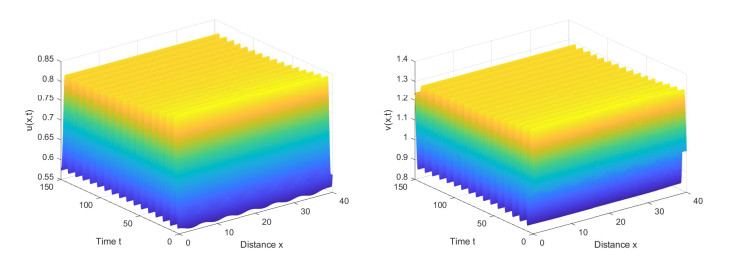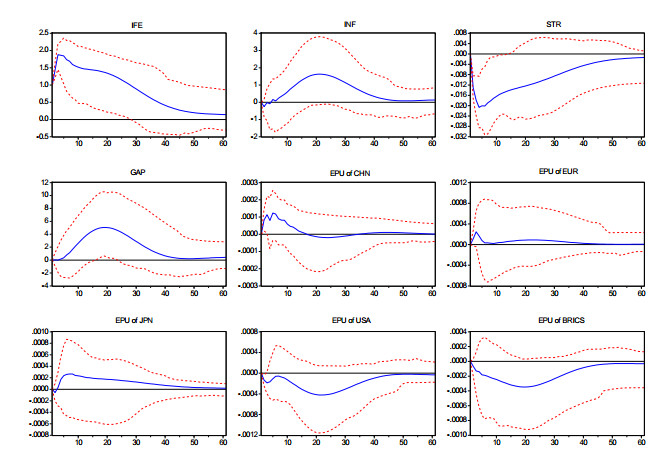In this paper, we evaluate the impact of economic policy uncertainty shocks on inflation expectations in China by using a MF-VAR approach. We find that China's inflation expectations are sensitive to policy-related uncertainty shocks. Meanwhile, there exist heterogeneous impacts of national economic policy uncertainty shocks on inflation expectations in China. Overall, the inflation expectations in China rise in response to the European, Japanese and China's own uncertainty shocks. Whereas, the reaction of the inflation expectations in China to the uncertainty shocks made by both the US and BRICS (except China and South Africa) is negative. The results also reveal that the policy-related uncertainty shocks are dominant driving force of the inflation expectations in China especially during the post-crisis period. In addition, the contribution of China's domestic uncertainty shocks is remarkably higher than that of foreign uncertainty shocks.
1.
Introduction
In nonlinear chemical reaction systems, the three-molecule autocatalytic model shows abundant dynamical behaviors, many abundant research results have been obtained [1,2,3,4,5,6,7]. In 1979, Schnakenberg proposed a typical three-molecule autocatalytic reaction-diffusion model [8]. In [9], the authors studied the one-dimensional static Turing bifurcation of Schnakenberg model. In [10,11,12], the authors introduced the relevant research background of reaction-diffusion Schnakenberg system. However, most references [13,14,15,16] focus on whether the constant equilibrium solution has Turing instability, but pay little attention to whether the periodic solutions of system may also suffer from Turing instability. Therefore, by applying the theoretical methods in [17,18], we study the Turing instability of Hopf bifurcating periodic solutions for the Schnakenberg model.
On the basis of the Schnakenberg model [8], We introduce self-diffusion and cross-diffusion coefficients, and establish reaction-diffusion Schnakenberg model with cross-diffusion and self-diffusion:
where Ω is a open bounded domain in n-dimensional Euclidean space, and its boundary ∂Ω is smooth. Δ is Laplace operator. The parameters a,b,d11,d12,d21,d22 are all positive constants. u=u(x,t) and v=v(x,t) indicate the concentrations of chemicals at position x∈Ω and time t>0, respectively, and the initial concentrations u∗(x),v∗(x) are nonnegative functions. d11,d22 denote self-diffusion coefficients of u and v, respectively. d12,d21 represent cross-diffusion coefficients of u and v, respectively. Simultaneously, we suppose that d11d22−d12d21>0 holds.
2.
Hopf bifurcation and stability of periodic solutions for the ODE system and perturbed system
2.1. Stability of periodic solutions for the ODE system
We consider the corresponding zero-dimensional dynamic system of system (1.1)
The equilibrium (u0,v0) of system (2.1) satisfies
with u0=a+b,v0=b(a+b)2. By straightforward computation, we know (u0,v0) is the only equilibrium of system (2.1). For convenience, setting μ:=a+b, then (u0,v0)=(μ,bμ2). In the following, for the three-molecule autocatalytic Schnakenberg model, we discuss the stability of its Hopf bifurcating periodic solutions by taking μ as parameter.
Theorem 2.1. Let μH0=3√b+√b2+127+3√b−√b2+127, for the ODEs (2.1), the following statements are true:
(1) At (μ,bμ2)T, system (2.1) is unstable for μ∈(0,μH0), while locally asymptotically stable for μ∈(μH0,+∞).
(2) At λ=μH0, system has a family of periodic solutions (uT(t),vT(t))T bifurcating from (μ,bμ2)T. Supercritical Hopf bifurcation of system (2.1) occurs at (μ,bμ2)T, and the bifurcating periodic solutions are stable.
Proof. The Jacobian matrix of system (2.1) at (μ,vμ)T is J(μ)=(−1+2bμμ2−2bμ−μ2). The characteristic equation of J(μ) is
with
The eigenvalue λ(μ) of J(μ) is given by
When μ≥2b, all the eigenvalues of J(μ) have strict negative real parts, according to the stability theory, the equilibrium (μ,bμ2)T is locally asymptotically stable. When 0<μ<2b, T′(μ)=−2μ−2bμ2<0, then T(μ) is monotonically decreasing for 0<μ<2b. Since limμ→0T(μ)=+∞,T(2b)=−4b−12b<0, then T(μ) has only zero point μH0∈(0,2b), namely, T(μH0)=0. For any μ∈(μH0,2b), we have T(μ)<0, then system (2.1) is locally asymptotically stable at (μ,bμ2)T, while for any μ∈(0,μH0), system (2.1) is unstable at (μ,bμ2)T. When μ=μH0, J(μ) has a pair of pure imaginary roots λ=±iω0 with ω0=μ. Let λ(μ)=α(μ)±iω(μ) be the roots of Eq (2.2) near μ=μH0, then we have
According to Poincaré-Andronov-Hopf bifurcation theorem, system (2.1) experiences a Hopf bifurcation at μ=μH0.
Next, we study the properties of Hopf bifurcating periodic solutions of system (2.1). Here, we still use the notations and computation in [20] to deduce the expression of cubic term coefficient c1(μH0) in the norm form. By [21], we can rewrite the Poincaré normal form of the abstract form of system (2.1) in the small neighborhood of p0 as follows:
Let the eigenvector of J(μH0) corresponding to the eigenvalue iω0 be q=(a0,b0)T satisfying
Define inner product in XC:
where Ui=(ui,vi)T∈XC,i=1,2. Note that ⟨λU1,U2⟩=ˉλ⟨U1,U2⟩, denote the adjoint operator of J(μH0) by J∗(μH0), then the eigenvector of J∗(μH0) corresponding to the eigenvalue −iω0 be q∗=(a∗0,b∗0)T∈XC satisfying
Therefore, q∗=(a∗0,b∗0)T=(−1−iμH02μH0lπ,−i2lπ)T. Performing the spatial decomposition X=Xc⊕Xs, where Xc={zq+ˉzˉq|z∈C},Xs={u∈X|<q∗,u>=0}, then for any U=(u,v)T∈X, there exist z∈C and ω=(ω1,ω2)∈Xs such that (u,v)T=zq+ˉzˉq+(ω1,ω2)T. Thus, system (2.3) can be transformed into the following system with (z,ω) as the coordinate:
with
Writing F0 as
here, Q,C is a symmetric multilinear form. For convenience, denoting QXY=Q(X,Y),CXYZ=C(X,Y,Z), we calculate Qqq, Qqˉq and Cqqˉq, where
here, denoting f(u,v)=a−u+u2v,g(u,v)=b−u2v, with
here, all the partial derivatives of f(u,v) and g(u,v) are evaluated at the bifurcation point (μH0,bμH02)T,
Let
from (2.5) and (2.6), we can obtain
Because system (2.4) has normal manifold, which can be written as follows
By (2.7), (2.8) and J(μH0)ω+H(z,ˉz,ω)=dωdt=∂ω∂zdzdt+∂ω∂ˉzdˉzdt, we have
By calculation, we have
we can also get H20=0,H11=0, this implies ω20=ω11=0, then
Thus, we have
The real part and imaginary part of c1(μH0) are as follows
By Rec1(μH0)<0, we know that the Hopf bifurcating periodic solutions of system (2.1) are stable at μ=μH0. Additionally, because transversality condition dα(μ)dμ|μ=μH0<0, so the direction of Hopf bifurcation is subcritical. □
2.2. Hopf bifurcation and stability of periodic solutions for the perturbed system
We introduce the following perturbed system model on the basis of ODEs (2.1)
here, ε is sufficiently small such that (1+εd11εd12εd211+εd22) is reversible. System (2.10) is equivalent to the following system
where
Then at (μ,vμ), the Jacobian matrix of system (2.11) is
with
The characteristic equation corresponding to the jacobian matrix J(μ,ε) is
where
Notice that H(μH0,0)=T(μH0)=0 and ∂μH(μ,ε)=T′(μH0)≠0. According to the implicit function existence theorem, there exist a sufficiently small ε0>0 and a continuously differentiable function μHε=μH(ε) such that when ε∈(−ε0,ε0), H(μHε,ε)=0 and μH(0)=μH0 hold. Let λ(με)=β(με)±iω(με) be the characteristic root of Eq 2.14, then when μ→με, we have
By [18], we have the following lemma.
Lemma 2.1. Assume μ is sufficiently close to μHε, T is the minimum positive period of the stable periodic solution (uT(t),vT(t)) of system (2.1) bifurcating from (μ,vμ), then there exists ε1>0 such that for any ε∈(−ε1,ε1), system (2.10) has a periodic solution (uT(t,ε),vT(t,ε)) depending on ε. Its minimum positive period is T(ε), simultaneously, it satisfies
1) When ε→0, (uT(t,ε),vT(t,ε))→(uT(t),vT(t)) and T(ε)→T.
2) T(ε)=2πω(μHε)(1+(β′(μHε)Im(c1(μHε))ω(μHε)Re(c1(μHε))−ω′(μHε)ω(μHε))(μ−μHε)+O((μ−μHε)2) with
Theorem 2.2. Suppose that μ is sufficiently close to μHε, (uT(t),vT(t)) is the stable periodic solution of system (2.1), then when ε→0, we have
with
Proof. According to Lemma 2.1, we have
If μ→μHε, then O(μ−μHε)→0, so the sign of T′(ε) is mainly determined by the sign of the first two at ε=0. Next, we calculate the expressions of dμHεdε|ε=0 and dω(μHε)dε|ε=0.
At μ=μHε, by (2.15), we can derive
Differentiating (2.17) with ε, we have
with
According to (2.16),
Differentiating it with μ, we know
When μ→μHε, H(μHε,ε)=0 and ∂λD(μHε,ε)=1N(ε)D′(μHε). Hence,
From ω(μHε)=√D(μHε,ε) and D(μHε,ε)=D(μHε)N(ε), differentiating them with ε, we can obtain
When ε=0, we get
Thus, according to (2.22) and (2.23), we have
where b(μH0) is defined in (2.19). From (2.21) and (2.24), we can obtain
By (2.18), (2.20) and (2.25), we can deduce
At last, substituting (2.19) into (2.26), we can obtain
with
□
3.
Turing instability of spatially homogeneous Hopf bifurcating periodic solutions
In this section, applying the theory elaborated in [17], we study stable spatially homogeneous Hopf bifurcating periodic solutions of system (2.1) will become Turing unstable in reaction-diffusion system (1.1) with cross-diffusion. According to the previous discussion, we give the following theorem.
Theorem 3.1. Suppose that μ is sufficiently close to μ0, (uT(t),vT(t)) is stable spatially homogeneous Hopf bifurcating periodic solution of system (2.1) bifurcating from (μ,vμ). If T′(0)<0 and Ω is large enough, then (uT(t),vT(t)) will become Turing unstable in system (1.1) with cross-diffusion.
Proof. Assume that the stable periodic solution of system (2.1) is (uT(t),vT(t)) with minimum positive period T, then the linearized system of (1.1) evaluated at (uT(t),vT(t)) is
where D:=(d11d12d21d22), Δ is Laplace operator, the Jacobian matrix of system (2.1) at (uT(t),vT(t)) is JT(t):=(−1+2uT(t)vT(t)uT2(t)−2uT(t)vT(t)−uT2(t)). Setting βn and ηn(x) be the eigenvalue and eigenfunction of −Δ in Ω with Neumann boundary condition. Let (ϕ,φ)T=(h(t),g(t))T∑∞n=0knηn(x), then
in which, τ:=βn≥0,n∈N0:={0,1,2⋯}. Assume d11=d12=d21=d22=0, then system (3.2) can be rewritten as
Let Φ(t) be the fundamental solution matrix of system (3.3) satisfying Φ(0)=I2. Denote λi,i=1,2 as the eigenvalue of Φ(T), the corresponding characteristic function is (Ni,Mi)T, i.e.,
then λi is the Floquet multiplier corresponding to the periodic solution (uT(t),vT(t)) of system (3.2). Define
apparently,
In system (2.1), differentiating with t, we have
Then 1 is the eigenvalue of Φ(T), the corresponding eigenvector is (u′T(0),v′T(0))T. We might as well assume λ1=1, (ϕ1(t),ψ1(t))T=(u′T(t),v′T(t))T. Since (uT(t),vT(t)) is stable, then |λ2|<1. Let Φ(t,τ) be the fundamental solution matrix of system (3.2), and Φ(0,τ)=I, namely,
For sufficiently small τ, Φ(t,τ) is continuously differentiable with respect to t and τ, and Φ(t,0)=Φ(t). Define mapping L:[0,+∞)×C×C2→C2, where C:=R⊕iR, we have
clearly, L(0,λi,(Ni,Mi)T)=(0,0)T and
here, Lδi is the Fréchet derivative of L with respect to δi, and L(ni,mi)T is the Fréchet derivative of L with respect to (ni,mi)T. Setting λi is the single eigenvalue of Φ(T), then we have
where Ker represents the kernel of λiI−Φ(T), and Rank represents the range of λiI−Φ(T), then L(δi,(ni,mi)T)(0,λi,(Ni,Mi)T),i=1,2 is an isomorphic mapping. By the implicit function theorem, there exist τ1>0, τ∈(−τ1,τ1) and continuously differentiable functions δi(τ),ni(τ),mi(τ) such that
where δi(τ),i=1,2 are the Floquet multipliers corresponding to (uT(t),vT(t)). Define
by Φ(0,τ)=I and (3.5), we can obtain
From (3.4) and (3.6), we have
Specifically, by (3.5), we have
By the definition of (ϕ1(t,τ),ψ1(t,τ))T in (3.5), we can obtain
Differentiating (3.8) with respect to τ and setting τ=0, we have
here, ϕ1τ:=∂τϕ1,ψ1τ:=∂τψ1. On the other hand, from (3.4) and (3.5), we can derive
Differentiating (3.10) with τ, we get
In (3.11), setting τ=0, from (3.6)and δ1(0)=λ1=1, we have
According to Lemma 2.1, (uT(t,ε),vT(t,ε)) is the periodic solution of system (2.10), that is,
Differentiating (3.13) with respect to ε and setting ε=0, we have
where ∂tuT(t,0)=ϕ1(t),∂tvT(t,0)=ψ1(t). Since (uT(t,ε),vT(t,ε)) is the periodic solution with period T(ε), thus,
In (3.15), differentiating with respect to ε and setting ε=0,t=0, then
here, uT(t,0)=uT(t),vT(t,0)=vT(t),T(0)=T. Define
From (3.9), (3.12), (3.14) and (3.16), we have
Let Γ(t)=Φ(t)(Y1,Y2)T be the general solution of (3.17), where any vector (Y1,Y2)T∈R2. Since (ϕ1(0),ψ1(0))T and (ϕ2(0),ψ2(0))T are linearly independent, then there exit constants γ1 and γ2 so that
Substituting (3.19) into (3.18), we can obtain δ′1(0)+T′(0)=0. Assume that T′(0)<0, which is equivalent to δ′1(0)>0, if Ω is large enough so that the minimum positive eigenvalue of −Δ is small enough, then there exists at least one eigenvalue βn of −Δ such that δ1(τ)=δ1(βn)>1. Thus, (uT(t),vT(t)) becomes Turing unstable in reaction-diffusion system (1.1) with cross-diffusion. □
4.
Numerical simulations
In this section, we shall select several groups of data for numerical simulations to support theoretical analysis. In system (1.1), Fix parameters a=0.1823,b=0.5, initial values u0=0.6+0.01cosx,v0=1+0.01sinx, then the equilibrium is (0.6823,1.074), μH0=0.6823278, Rec1(μH0)=−0.5<0, Imc1(μH0)=−0.0270945<0. According to Theorem 2.1, system (2.1) produces a spatially homogeneous Hopf bifurcating periodic solution (uT(t),vT(t))T at the equilibrium, which is stable and subcritical. By calculation, we can obtain
For different diffusion coefficients, Turing instability of system (1.1) at the periodic solution (uT(t),vT(t))T is different. Hence, we give diffusion coefficients in four cases and carry out corresponding numerical simulations.
(1) If we select d11=1,d22=1,d12=d21=0, at this moment, Turing instability of (uT(t),vT(t))T does not exist in system (1.1) (Figure 1). That is, the same diffusion rates will not cause Turing instability of periodic solution ([19]).
(2) If we select d11=0.05,d22=2,d12=d21=0, then
According to Theorem 3.1, system (1.1) is Turing unstable at periodic solution (uT(t),vT(t))T. Through simulation simulation, it can be observed that the stable periodic solution produces Turing bifurcation (Figure 2), which is consistent with the theoretical analysis.
(3) If we choose d11=d22=1,d21=0.2,d12=1.05, from Theorem 3.1, we have
then system (1.1) is Turing unstable at periodic solution (uT(t),vT(t))T. Through simulation simulation, it can be verified that the stable periodic solution generates Turing bifurcation (Figure 3). Therefore, cross-diffusion causes the stable periodic solution of system (1.1) to become Turing unstable. self-diffusion induces Turing instability of periodic solution.
(4) If we choose d11=0.5,d12=1.5,d21=0.6,d22=4, then
By Theorem 3.1, we can derive that diffusion causes the stable periodic solution of system (1.1) to become Turing unstable (Figure 4). This conforms to the theoretical analysis.
5.
Conclusions
In this paper, a three-molecule autocatalytic Schnakenberg model with cross-diffusion is considered. From both theoretical and numerical perspectives, we investigated how cross-diffusion causes the Turing instability of spatially homogeneous Hopf bifurcating periodic solutions.
The theoretical results indicate that in the Schnakenberg model, when the parameters satisfy certain conditions and Ω is sufficiently large, once the instability of periodic solutions induced by diffusion occurs, new and rich spatiotemporal patterns may emerge. For the reaction-diffusion Schnakenberg model, we can derive the precise conditions of diffusion rates, under which the periodic solutions may experience the instability caused by diffusion.
By numerical simulations, the Turing instability of periodic solution (uT(t),vT(t))T can be observed. Figure 1 shows that without cross-diffusion coefficients, the identical self-diffusion coefficients will not cause the stable periodic solution to produce Turing bifurcation. Figures 2 and 4 illustrate that with appropriate diffusion coefficients, the stable periodic solution of system (1.1) generates Turing instability. Figure 3 indicates that if we select appropriate cross-diffusion coefficients, even for the models with identical self-diffusion rates, cross-diffusion can also cause stable periodic solution to produce Turing bifurcation. Thus, the Turing instability of stable periodic solution (uT(t),vT(t))T is actually induced by cross-diffusion.
Conflict of interest
The authors declare there is no conflicts of interest.










 DownLoad:
DownLoad:









